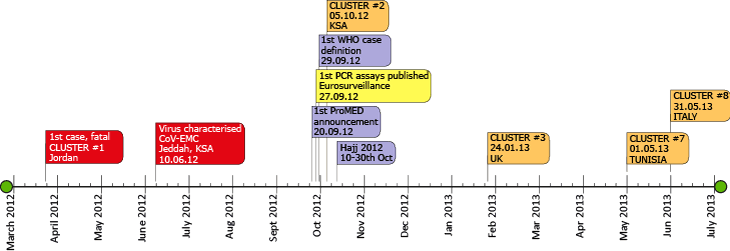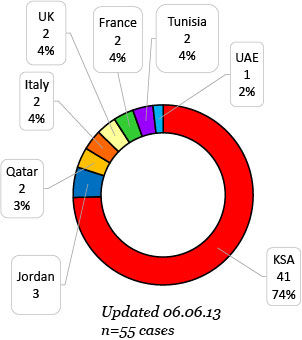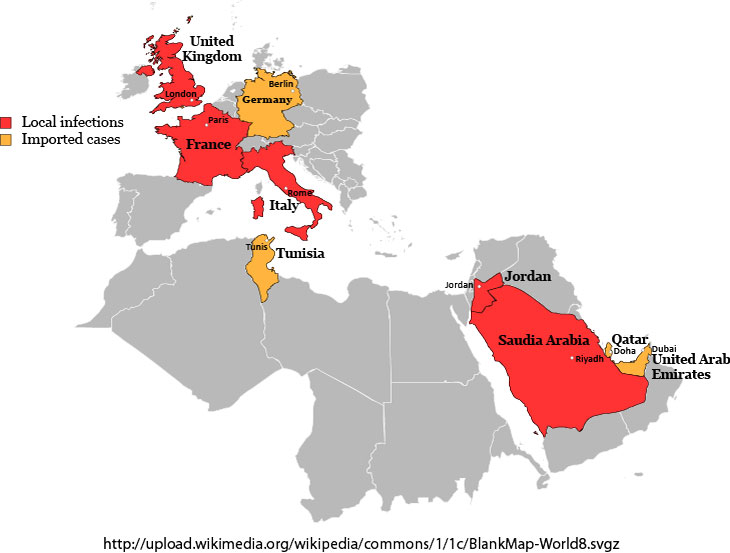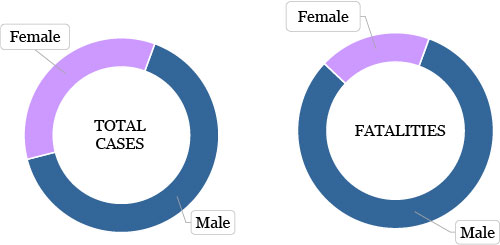Members of the subfamily Coronavirinae that infect humans currently include the respiratory coronaviruses HCoV-OC43 (a betaCoV), HCoV-229E (alphaCoV), HCoV-NL63 (alphaCoV), SARS-CoV (betaCoV), MERS-CoV and HCoV-HKU1 (both betaCoV).
Quick numbers
As of 06th June; FluTrackers, CIDRAP, WHO
- Total human cases of MERS-CoV: 55a
- Total deaths attributed to infection with MERS-CoV: 33
- Current Case Fatality Rate (CFRd): 61%
b This uses numbers based on publicly available data which may lack detail. This number gives you an idea of our understanding at the moment. To be pedantic and use only the number of discharges as the denominator for the CFR is most useful at the end of an outbreak/epidemic/pandemic, but not so much when data-in-hand is poor during the beginning.

Genetics
A schematic of the complete genome of the first fully sequenced MERS-CoV variant in lineage C of the betacoronaviruses; HCoV 2c EMC/2012.1 Drawn to scale based on GenBank sequence JX869059. This genome shares 99% nucleotide identify with two other fully sequence variants, Human betacoronavirus 2c England-Qatar/2012 (KC667074) and Human betacoronavirus 2c Jordan-N3/2012 (KC7761745) complete genomes.
Early MERS-CoV cases
Cluster numbering using the US CDC scheme
The first case was admitted to hospital in April 2012
The first case, admitted to hospital 10th June 2012, to yield a characterised virus was a previously healthy non-smoker who died after community-acquired pneumonia progressed to acute respiratory distress syndrome (ARDS) and acute respiratory failure (ARF). No contacts were positive.
Nasal swabs from 154 French pilgrims collected before and after Hajj-2012 tested negative for the CoV using Corman's assays5, despite 90% suffering from respiratory symptoms during their stay in Saudi Arabia.8
By far, most MERS-CoV cases have originated for eh Kingdom of Saudi Arabia (KSA). The adjacent figure provides a graphical representation of the available data.
A number of human clusters have been reported:
Cluster 1: Jordan, 2 cases/2 of whom died: Utilising a WHO collaboration (via a United States Naval Medical Research Unit No. 3 [NAMRU-3] team in Cairo, Egypt), the Jordanian Ministry of Health sent samples from an outbreak of severe pneumonia among mainly healthcare workers during April 2012, for characterization. At the time (24th April, 2012)the samples were negative for normal coronaviruses as this preceded the existence of any MERS-CoV-specific diagnostics. However, 2 deaths from this time were subsequently confirmed as RT-PCR positive to, or had an antibody-conversion against, the MERS-CoV by NAMRU-3 (November, 2012; once tests were in use).11. Patient 1-25M University student, onset 21.03.12, 7d cough, fever, shortness of breath, died 25.04.12; Patient 2-40F intensive care unit nurse, onset 02.04.12, death 19.04.12)11. A mission from the WHO Eastern Mediterranean Regional Office (EMRO) was despatched on the 29th November to assist with surveillance. A complete genome (Human betacoronavirus 2c Jordan-N3/2012) is available from this cluster. 124 samples were sent to the US CDC ion late May 2013 for retrospective analyses.
Cluster 2: Saudi Arabia, 4 cases/2 deaths: This was a family cluster of four cases and two deaths.12 Patient 1 (70M), showed signs of disease from Oct 5, 2012 was hospitalized Oct 13 and died Oct 23 from cardiogenic and septic shock. He was given steroids. He had type 2 diabetes, ischemic heart disease and hypertension. Patient 2 (39M), eldest son of Patient 1, presented Oct 28 after 4 days of fever, rigors, anorexia and a productive cough requiring continuous positive airway pressure (CPAP) until his oxygen levels normalised and he was discharged. He was re-admitted, this time to intensive care, on Oct 29. He was given oseltamivir Oct 26 but died Nov 2. He was a chronic smoker with a history of airway disease. Patient 3 (16M), eldest son of Patient 2, reported malaise (feeling rotten), fever, sore throat, cough, wheeze and anorexia from Nov 3 and was admitted with a measurable fever, continuing symptoms and diarrhoea and abdominal pain. He was discharged Nov 11. Patient 4 (31M), brother of Patient 1, reported fever, rigors, night sweats and productive cough Nov 4 and was admitted Nov 6 and discharged Nov 14. He was a smoker. All were treated with oseltamivir and antibiotics.
Cluster 3: United Kingdom, 3 cases/2 deaths: Illness in a 60-year old male (60M) returned from travelling in Pakistan and Saudi Arabia led to his hospitalization during which he tested positive for the MERS-CoV (Feb 1)9. A second, non-travelling adult male with an underlying medical condition, also from the same household died after contracting the virus and becoming ill on Feb 5 after hospital-based contact with the index case. A female became ill Feb 5 after contact with the index case in hospital and recovered, as an outpatient, by Feb 19. This family cluster was classified as person-to-person transmission.
Cluster 4: Saudi Arabia:
Cluster 5: Saudi Arabia:
Cluster 6: France, 2 cases/1 death: A 64M became symptomatic on 22nd of April, 5-days after returning to France from travelling to Dubai.10 He was hospitalized on the 24th, subsequently required extracorporeal membrane oxygenation (ECMO)and died 28th May due to multiple organ failure. The second case in this cluster was a 51M who became ill while located 1.5m from 64M, in the same hospital room for 3-days (admitted for unrelated reasons). Like other visitors and healthcare workers, he wore no mask. 51M was released from hospital Apr 30 but was admitted to another hospital May 9 with symptoms. His infection was confirmed May 11, he suffered respiratory failure May 12 and remains hospitalised.
Cluster 7: Tunisia:
Cluster 8: Italy: The index case, a 45M Jordanian local returned to Tuscany, Italy after a 40-day trip to Jordan while ill. Upon his return on the 25th of May he already had fever, cough and difficulty breathing. He went back to work for at least 1 day before seeking medical care. He was hospitalised on the 28th of May and is stable. 45M's son also suffered an acute respiratory illness but remains in Jordan. 45M's granddaughter (1.5-year old; coughing and fever, Meyer Children's Centre) was in contact the previous Sunday (approximately 6-day incubation) and, along with a work mate, both tested positive. Neither are severe cases. 45M and his work mate both work in a hotel in Florence
Global distribution of MERS-CoV cases
Cases are all be linked to a point of origin in the Arabian Peninsula, in particular, the Kingdom of Saudi Arabia (KSA).
Transmission
Risk assessments from the European CDC (ECDC; 17.05.13) suggest the need to (1) be on alert for cases with severe respiratory symptoms, also including systemic disease, especially in patients with underlying conditions, that have travelled from Arabian Peninsula, (2) include patient samples from the lower respiratory tract, not just the nasopharynx/throat.
The MERS-CoV variant that has been most well characterized, HCoV-EMC, does not use the same cell receptor (angiotensin-converting enzyme 2; ACE2)as the severe acute respiratory syndrome (SARS) CoV, and can infect human, pig and bat cells.6
Large droplet transmission is suspected as the most likely route.10
Most MERS-CoV cases are in males (includes surviving and fatal cases) but the bias towards males among the fatal cases is extreme. This is likley linked to the high proportion of underlying medical conditions among males who died and were positve for the virus. It may also be due to some other factor that puts males at greater risk of exposure to the suspected animal host(s) of MERS-CoV.
Case definitions
The presumed incubation period is between 9 and 12-days.10
Animal host
Bats are the suspected host for this presumed-to-be-zoonotic MERS-CoV, based on the finding of genetically related CoVs (found in the Japanese pipistrelle, Pipistrellus BatCoV-HKU5 and the lesser bamboo bat, Tylonycteris BatCoV-HKU47). Most of the ground breaking work in finding CoVs in bats comes from The University of Hong Kong.7
One case from Abu Dhabi in the United Arab Emirates (UAE) had been exposed to a sick camel.
No animal host for the MERS-CoV has been confirmed to date but animal samples are to undergo analysis in US labs.
Diagnostics and detection
The MERS-CoV strain HCoV-EMC can be grown in cell culture using LLC-MK2 and Vero cells.1,2 This method has been used to produce antigen for detection antibodies in humans via immunofluorescence methods.1,2 The HCoV-EMC strain also replicates in fully differentiated human airway bronchial epithelium (HAE) cultures grown at the air-liquid interface (ALI).4
The first genetic detection of a MERS-CoV was completed using a conventional (non-real-time) pan-coronavirus RT-PCR.3 More specific real-time RT-PCR (RT-rtPCR) assays were described subsequently.5
Immune response
HAE Cultures indicated 4
Therapies and interventions
There is no specific drug or vaccine available for the MERS-CoV although drug testing of US FDA-approved potential formulations is underway at the Small-molecule Inhibitor Leads Versus Emerging and neglected RNA viruses (SILVER) project.
The literature
- A.M. Zaki et al. Isolation of a Novel Coronavirus from a Man with Pneumonia in Saudi Arabia. N Engl J Med. (2012) 367;19:1814-20.
- K-H Chan et al. Cross-reactive antibodies in convalescent SARS patients' sera against the emerging novel human coronavirus EMC (2012) by both immunofluorescent and neutralizing antibody tests.J Infection (2013) S0163-4453.
- C Drosten et al. Identification of a novel coronavirus in patients with severe acute respiratory syndrome.N Engl J Med. (2003) 348:1967-76
- E. Kindler et al. Efficient replication of the novel human betacoronavirus EMC on primary human epithelium highlights its zoonotic potential.MBio (2013) 4(1):11-12
- V.M. Corman et al. Detection of a novel human coronavirus by real-time reverse-transcription polymerase chain reaction.Euro Surveillance (2012) 17(39).
- MA Muller et al. Human coronavirus EMC does not require the SARS-coronavirus receptor and maintains broad replicative capability in mammalian cell lines.MBio (2012) 3(6):e00515-12.
- PCY Woo et al. Molecular diversity of coronaviruses in bats.Virology. (2012) 351(1):180-187.
- P Gautret et al. Lack of nasal carriage of novel corona virus (HCoV-EMC) in French Hajj pilgrims returning from the Hajj 2012, despite a high rate of respiratory symptoms. Clin Microbiol and Infect. (2013)
- Update: Severe respiratory illness associated with a novel coronavirus-worldwide, 2012 - 2013. MMWR Morbidity and Mortality Weekly Report, 2013, 62(10):194 - 195
- B Guery et al. Clinical features and viral diagnosis of two cases of infection with Middle East Respiratory Syndrome coronavirus: a report of nosocomial transmission.Lancet (2013).
- Hijawi et al. Novel coronavirus infections in Jordan, April 2012: epidemiological findings from a retrospective investigation. EMJH. 19(S1):S12-S18.
- Memish A et al. Family Cluster of Middle East Respiratory Syndrome Coronavirus Infections. NEJM. May 29 2013







I don't understand why something called flu-trackers is tracking something that's NOT flu. I mean, its a different virus species, isn't it? Mostly responsible (in humans) for the common cold (upper respiratory tract infection)?
[Link]
From Above:
"Coronaviruses are rather unstable and transmission of the virus is by transfer of nasal secretions caused by sneezes, such as in aerosols. Viruses that infect epithelial cells of the enteric tract cause diarrhea. This is most common in young animals where the infection can be fatal. Although local, coronary infections can spread as well.
Most infections cause a mild, self-limited disease but there may be rare neurological compliations as well. SARS is a form of viral pneumonia where infection encompasses the lower respiratory tract.
Coronaviruses mainly target epithelial cells but they also infect macrophages and other widely distributed cells. These viruses have relatively restricted host ranges, infecting only natural host and closely related animal species. Coronavirus biological vectors are not known. "